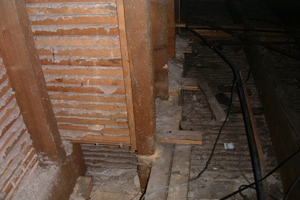Woodworm
 Can central heating control woodworm?
Can central heating control woodworm?
Television viewers with a keen interest in woodworm may have seen BBCs "Raising The Roof" broadcast on 10
February 2000.
As an independent consultant in the field I found the program interesting as well as entertaining since it suggested that some of my own knowledge and beliefs might be wrong. Such instances are rare in my 20 year professional career, and I immediately dived into my technical archive to re-acquaint myself with the evidence and the facts.
However my excitement was short lived. The evidence suggests that myself and others were right all along.
Leaving aside the theatrical stunts and the dart holes I will just concentrate on the technical aspects.
Also since there are many types of woodworm I will deal only with common furniture beetle ( Anobium punctatum )
The Technical Issues:
The principal assertion of the program was that woodworm is rare in buildings and that this is due to central heating because central heating keeps the wood at a low enough moisture content to kill woodworm.
Technical summary
There are documents published by the Building Research Establishment that state that wood moisture levels of 12 % or less do not sustain woodworm ( Anobium punctatum ) growth and development. The evidence I have seen to support this was published in 1942 and 1983. However it is not suggested by the authors that it would be a satisfactory means of woodworm control. I learned from Graham Coleman, another consultant, that the information supporting the hypothesis that central heating kills woodworm came from "surveys of the incidence of woodworm" carried out by the BRE There is
little evidence to support that drying timber to this level will kill an established attack. It would be useful to know for how long the wood requires to be maintained at 12 % to kill an established infestation especially if this is to be used as a means of control.. In addition to this what about inactivity. Perhaps the reduced moisture simply slows down the life cycle which might speed up again once more favourable conditions are restored.
Anyway lets assume that that wood moisture of 12% or less does kill woodworm. What are the chances
of keeping wood moisture at 12% with or without central heating?.
The hygroscopic properties of wood are well known and well understood Data I collected from a publication of US Forest products research Institute illustrates that relative humidity is the important factor in determining the moisture content of air dry wood. They state that wood species does not
make much difference and from the temperature data they present the temperature effects within the range found in buildings are slight.
The relative humidity must be maintained at around 60% or less to maintain wood moisture at 12 %.
This might be possible in a floorboard in a well-heated and ventilated building. It is impossible in this climate to achieve and maintain this in a roof void or an underbuilding or a sub floor joist, or indeed anywhere else where you are likely to find woodworm in buildings.
The levels of relative humidity will vary a great deal within the property and at various times of the day.
I would suggest this was more to do with the external environment and the detail of construction than the central heating.
Briefly, for someone to take one moisture measurement from one sample as they did in the program and declare the property free from active woodworm is in my opinon absurd. Any specialist who relied on such an unreliable method and unrepresentative sample is open to criticism.
Central heating in a building does not always result in reduced relative humidity. It depends also on the external
conditions and the ventilation. In addition it is not in use at all times of the day and all year round. Indeed during the summer months when woodworm is most active most central heating systems are not in use at all.
Insulation can have a pronounced effect, especially in roofs. To assume therefore that central heating will maintain the moisture levels in wood at 12 % is nonsense.
To rely on it for woodworm control is recklessly optimistic at best and perhaps even negligent.
If you would like more detailed information please eMail me.
Back to Technical Articles. Top
|